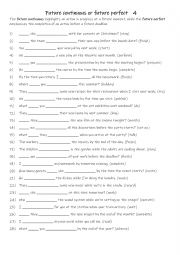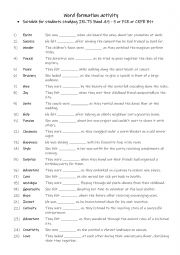|
Printables |
PowerPoints |
Online exercises |

|
A1+-A2 Genitives (6)
This worksheet is suitable for A1+-A2 level students. Genitives refer to a grammatical case or construction used to indicate possession or a close relationship between nouns. Students complete the 20 sentences after reading the rules. Answers on page 2
Level: elementary
Age: 8-100
Type:
Downloads: 131
|

|
Identifying and correcting sentence fragments 4
First, students need to familiarise themselves with identifying and correcting sentence fragments. Then they read the sentences to identify and correct the issue and punctuate all of the sentences Answers on page 2.
Level: elementary
Age: 8-100
Type:
Downloads: 131
|

|
A1-A1+ Practise with present continuous tense using all forms positive, negative, question & wh-question 3
Each form is used 6 times! Answers on page 2.
Level: elementary
Age: 7-100
Type:
Downloads: 131
|

|
A2+-B1 Future continuous or future perfect 4
Understanding these tenses allows students to communicate future goals, schedules, and timelines effectively, enhancing both their speaking and writing skills for academic, professional, and everyday use. First, students need to familiarise themselves with the 2 tenses and their use. Then they read the sentences to work out which tense is needed to...
Level: elementary
Age: 9-100
Type: worksheet
Downloads: 131
|

|
A2-B1 Practise with present simple, present continuous, past, simple, past continuous and present perfect 4
Students at A2-B1 level should practise the present simple, present continuous, past simple, past continuous, and present perfect tenses as they form the foundation of clear and effective communication. These tenses enable learners to discuss routines, habits, and facts, describe ongoing actions, recount past events, and share experiences or achiev...
Level: elementary
Age: 8-100
Type:
Downloads: 131
|

|
A1+ A2 Practise with past simple, past continuous & present perfect 6
First, students need to familiarise themselves with the 3 tenses and their use. Then they read the sentences to work out which one is needed to complete the gap-fill using the given verb in (). Each tense is used 9 times! Answers on page 2
Level: elementary
Age: 7-100
Type:
Downloads: 130
|

|
Word formation activity B1+
Word formation exercises improve learners� understanding of how words are constructed. This includes recognizing prefixes, suffixes, roots, and combining forms. Such knowledge helps learners break down complex words into understandable parts, making it easier to grasp their meanings.This worksheet is suitable for students studying IELTS Band 4.5 ...
Level: intermediate
Age: 12-100
Type: worksheet
Downloads: 130
|

|
A1-A2 Prepositions: in - at -on
Students read the sentences to see which preposition is needed to complete the gap-fill. Answers on page 2.
Level: elementary
Age: 7-100
Type:
Downloads: 130
|

|
A1-A2 Practise with verb to be & to have - positive & negative forms using present simple tense
Students read the sentences to work out if what form of the verb to be & to have is required to complete the gap-fill. Answers on page 2.
Level: elementary
Age: 7-100
Type:
Downloads: 130
|

|
A2-B1 Intensifiers: so and such practise
Learning how to use "so" and "such" is important because they help students emphasise their statements and make their speech and writing more precise and expressive.Mastering "so" and "such" instead of relying on words like "very" and "really" adds variety to language, making it more dynamic and interesting. First students familiarise themselves wi...
Level: intermediate
Age: 8-100
Type:
Downloads: 130
|
|
|
|
|












